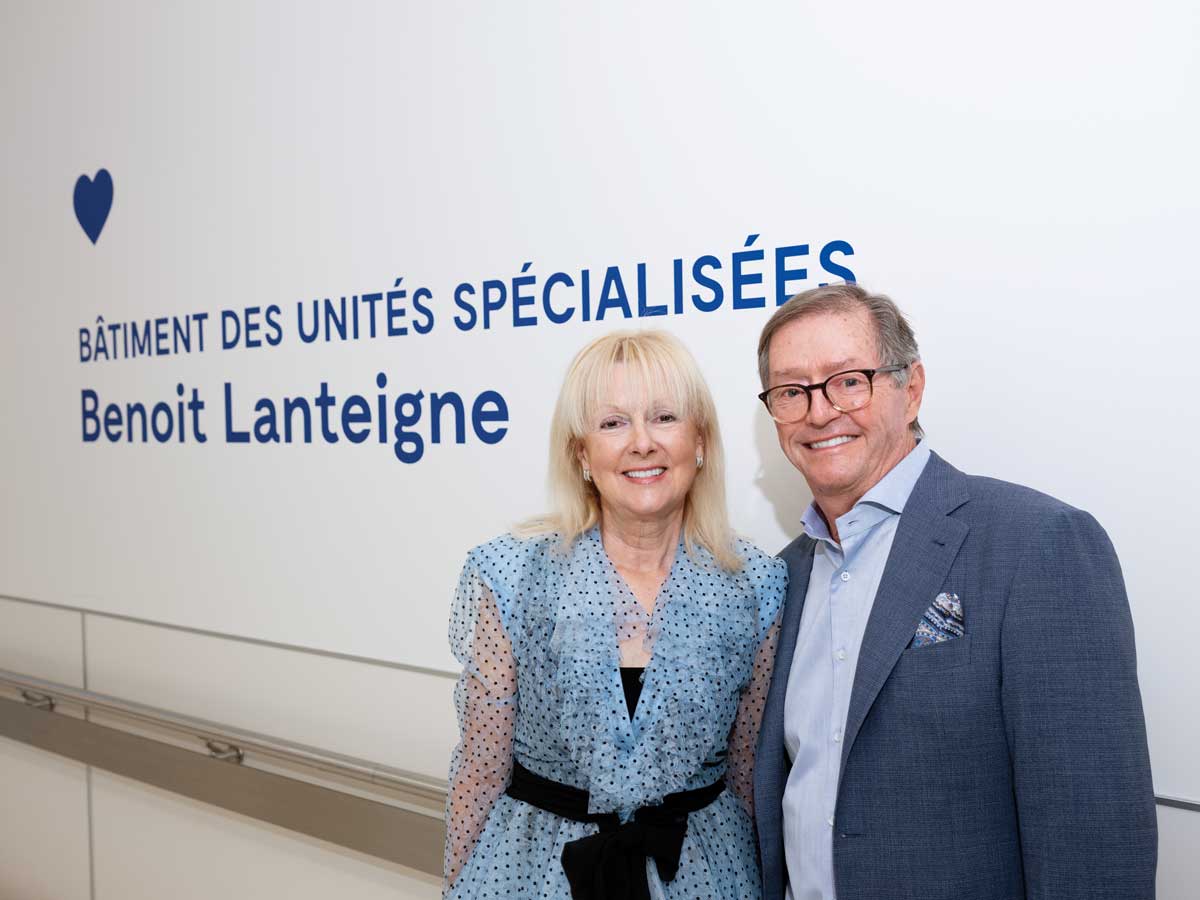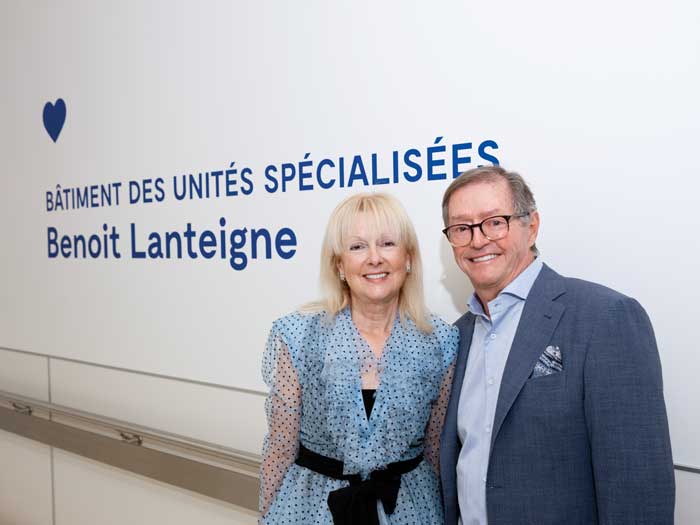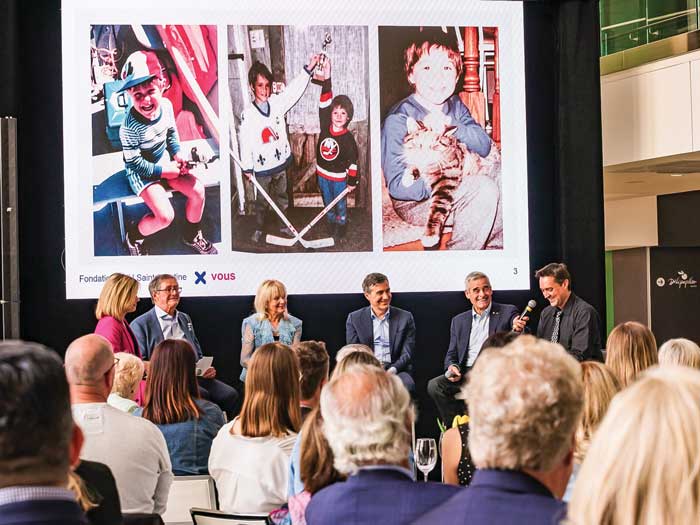
Giving back: the $40-million dollar question
 After exploring how best to put their savings to work, Michel Lanteigne and Diane Blais decided to focus their bequest on supporting children’s health (Photograph by Guillaume Simoneau)
After exploring how best to put their savings to work, Michel Lanteigne and Diane Blais decided to focus their bequest on supporting children’s health (Photograph by Guillaume Simoneau)
After careers spent rising through the ranks at EY, both as partners—he as a tax specialist and she as a consultant—Michel Lanteigne and Diane Blais were enjoying a well-earned retirement. Lanteigne had spent the final three years of his career as a global tax leader based in London, England, and commuted back across the pond to Montreal on weekends to spend off-hours with Blais, who was enjoying a life closer to home.
As the couple grew older they wondered how they could put their $40 million savings to work, not only to create a legacy, but more critically to create an impact?
With 80 years of combined experience at EY, they were no strangers to working together—they even co-authored a book on financial planning in the nineties. “We’re used to being a team,” Lanteigne says.
The couple had previously written wills with separately-chosen bequests. “But we thought that putting together all that money would have a more significant impact than giving a little here, a little there,” Blais adds.
While Blais planned to distribute her bequest among multiple causes, for Lanteigne there’s always been one particularly close to his heart. In 1989, Benoit, his son from a previous marriage, died at age eight from leukemia. He’d spent more than half his life ill, before passing away in Lanteigne’s arms. At the time typically only half the number of children with the illness survived.
Despite medical advances in the past thirty-plus years, one in 10 children with leukemia still die from the disease and about 1,500 Canadian children receive a cancer diagnosis annually, with roughly 20 per cent of them in Quebec. Over the years, the couple helped raise millions for organizations like Foundation of Stars, a non-profit supporting paediatric medical research in Quebec. Lanteigne even served on its board, and that of the Montreal Children's Hospital, where Benoit received treatment. Eventually Blais decided that she too would direct her wealth to supporting children’s health.
As natural as Lanteigne’s decision was, he was struck by Blais’ remarkable generosity. Blais wasn’t Benoit’s mother (the pair don’t have children together), and though volunteering time and energy to children’s causes is one thing, to devote the fruits of an entire career is another. “It takes a special woman to do something like this,” Lanteigne says.
The couple started discreetly taking meetings with different Montreal-area hospitals: the Montreal Children’s Hospital, the Jewish General Hospital, and the Centre Hospitalier Universitaire Sainte-Justine to learn how their $40 million—what would become the largest donation to date to a hospital in Quebec—could be put to work. They wanted the money specifically to help children with cancer and not simply support the hospital overall.
In the past, the biggest consideration behind donations, large or small, was often if donors were emotionally connected to a cause. For instance, Myron and Berna Garron have donated millions to healthcare institutions in memory of their son Michael, including $50 million to the East Toronto hospital which now bears his name. Across the country, philanthropist causes and passions are reflected in namesake buildings, educational institutions and scholarships. But increasingly donors, Blais and Lanteigne included, are looking deeper, wanting their gifts to create impact; seeking to know how and when funds will be used and to look for a fit between the goals and values of donors and recipients. There are also questions about how to structure such donations to ensure charities and donors alike are each benefiting and by making sure they are tax advantaged.
With the big picture decided, but still many new questions to answer, Blais and Lanteigne found themselves in familiar territory. “We started our project like we would have done with a client project at EY,” Blais says.
Bruce Ball, CPA Canada’s vice-president of taxation, notes that sometimes donors making larger gifts can be less worried about taxes. He even remembers working with one client who wanted specifically to make a large one-time donation, even though it would have been more tax-efficient for the client to spread it out.
“You get a five-year carry forward if you make gifts during your lifetime,” he says. “A larger gift might be easier to use from that perspective—more years to spread it out.”
 Diane Blais and Michel Lanteigne at the announcement of the new CHU Sainte-Justine wing (Photograph courtesy of CHU Sainte-Justine Foundation)
Diane Blais and Michel Lanteigne at the announcement of the new CHU Sainte-Justine wing (Photograph courtesy of CHU Sainte-Justine Foundation)
A bigger concern today is “impact,” as in creating measurable environmental or social benefits. It has gone from a fringe of the business world to a mainstream talking point. Investors look at ESG criteria or other impacts when putting money to work. Consumers seek products from local suppliers or companies which create positive offshoots. And charitable donations aren’t just expected to do good, but to create a measurable good.
Consider the headline-making donations from Mackenzie Scott (formerly Bezos, of Amazon fame). She has donated more than US$14 billion of her wealth with the goal of creating impact for a variety of organizations and, in turn, for the work they do. On her website, Yield Giving, is a set of criteria she uses to direct her giving, with measurements like “high potential for sustained positive impact, including stable finances, multi-year track records, measurement and evidence of outcomes, and experienced leadership representative of the community served.”
But it’s not only billionaires asking these questions. Even everyday donors making modest donations seek this information, which is increasingly at their fingertips. It’s not only highlighted in annual reports, but on websites like Charity Intelligence or GiveWell.org, which provide impact data for donors to compare between charities.
While donors like Blais and Lanteigne often contribute funds to organizations they have a connection or history with, some giving habits are shifting, says Sharilyn Hale, a former non-profit executive and founder of the Watermark Philanthropic Counsel in Toronto.
“Increasingly, they are looking for organizations they can partner with to accomplish something specific, even if it’s an organization new to them, so research and conversations about goals and alignment become very important,” she says.
Though hospitals and universities still get the largest gifts, Hale has noticed the new generations of donors wanting to fight the climate crisis (now the third most common charitable cause in Canada) and “looking very closely at social and economic justice and ways to tackle these issues at a systemic level.”
In Canada, donors like Blais and Lanteigne with a net worth of over $1 million are among the biggest influences for philanthropy. They’re estimated to make 60 per cent of all claimed donations, and the areas they choose to fund can significantly affect environmental, health and social issues which impact wide swaths of Canadians.
Hale says one of the most critical questions that donors in this range need to ask themselves when donation planning is if they have confidence in the organization, including its leadership and its ability to deliver. But it's also critical to ask more practical questions, including terms of the gift, like how it will be funded and fulfilled.
Adam Aptowitzer, a tax lawyer with KPMG in Ottawa, adds that clients need to consider what assets they’re looking at donating. “For example, if you have environmental property, there are tax advantages to giving it to, let's say, a land trust, [rather] than giving it to a soup kitchen.” He also says it's important to discuss donations with family members. He knows of a donor who was once interested in bequeathing an art collection to a charity, but hadn't discussed it with their children before making the first overtures. In the end, the kids wanted to keep some of the most valuable works. This led the charity to lose interest in the donation as the value of the donation changed significantly.
For Blais and Lanteigne the most critical questions as they started the process, which ultimately lasted approximately eight months, was the timeline of when they could see the first child benefitting from their donation.
“If we can save one kid, then for Diane and I, I think we'll be able to say we've done our little part,” Lanteigne says. “We want to have an impact, and we want to see it while we're alive.”
Though Lanteigne had familiarity with childhood cancer from Benoit’s experience, the couple took it upon themselves to learn about the medical technology in use today. They wanted to make sure they chose a project based on the most recent data and with a well-thought-out plan. It wasn’t enough to be forward-looking. They wanted a clear, specific plan including who was going to be involved to bring it to fruition.
Their process involved little strict planning, they say, but there were a lot of meetings with different stakeholders—from hospital executives to researchers—to see where there was common ground between their needs and those of the hospitals. While the hospitals knew the couple were shopping their donation around, the pair kept the exact details of each proposal under wraps.
“If we can save one kid, then for Diane and me, I think we can say we’ve done our little part,” says Michel Lanteigne. “We want to have an impact, and we want to see it while we’re alive”
The best meetings during the process brought more than just fruitful discussions about potential projects to the table. “The feeling they gave us was comforting,” Blais says. “It’s something that wasn't just a technical discussion. It was deeper than that.” But not every donor has to go so in-depth. One tactic that donors can take, Lanteigne suggests, is reviewing past achievements and future plans of a potential recipient organization to see how they align with donor values.
Lanteigne also wanted the donation to be structured efficiently to create results but, as a tax expert, he also wanted it to be tax-efficient. That’s why the donation is being made annually, along with the balance to be donated to the foundation upon their deaths. Lanteigne hopes that making the donation as tax-efficient as possible will not only maximize the donation, but perhaps allow it one day to total more than the $40 million promised.
Once all the information was in their hands, it wasn’t easy to decide.
“All the projects were very interesting, very focused,” Blais says. “We found at one point that $40 million was not enough. We would have liked to give to [all] three of them.”
But in the end, they could choose only one.
On December 15, 2022, the announcement went public and became headline news across Quebec. Blais and Lanteigne were donating $40 million to the CHU Sainte-Justine Foundation to support pediatric oncology research.
“A portion of this gift will create the Innovative Oncology and Hematology Treatment Development Fund, supporting important work that begins today thanks to their generosity,” the hospital stated in a release.
The fund, created by several CHU Sainte-Justine doctors, is designed to explore new treatments for childhood cancers—which may include techniques like genome editing and stem cell engineering—that can help children in Quebec while contributing to knowledge in the wider field of childhood cancer treatment.
Neither Blais nor Lanteigne were content to sign a cheque and have that be the end of their involvement with the project. The pair will sit on a governance committee that oversees the project, and Lanteigne notes that the lead researcher “can feel the pressure” that the couple wants to see results. The first results of advancements funded by the couple’s donation may occur in as early as two years, in 2025.
With the announcement came a coda: the hospital’s specialized care building will soon bear the name of Benoit Lanteigne.
The couple says giving the donation in December was the best Christmas gift they’ve received, and after the news came out, they received touching notes from old friends and coworkers and parents of sick children.
He notes that losing a child affects a parent for a lifetime, but that going through the donation process brought him and Blais new feelings of happiness and serenity.
It also offered a new goal to aspire to, with the sort of impact they couldn’t have in other projects they worked on during their careers.
“If we can help save the life of another little Benoit out there, then we will have done something worthwhile,” Lanteigne says.
ON VOLUNTEERING AND WORKING FOR NFPs
Read about three CPAs who volunteer with CPA Canada. And if you’re embarking on a career in the NFP sector, look into CPA Canada’s not-for-profit certificate.